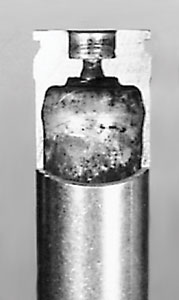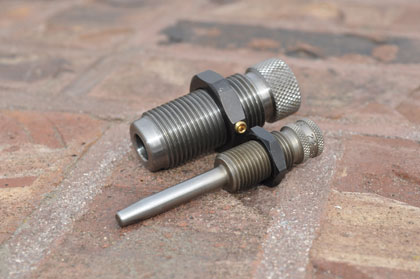January 04, 2011
By Allan Jones
At the risk of tipping someone's sacred cow, I'm going to talk trash about the belted rifle case and how it can negatively affect the average reloader.
By Allan Jones
 All rifle cases stretch with firing, but some belted cases grow thin faster, shortening case life. (Photo courtesy of ATK Inc.; used with permission) |
The belted rifle case was an invention of the great British gunmaking firm Holland & Holland. The company adapted the belt to a number of cartridges, including the excellent .375 H&H and .300 H&H Magnums. These rimless and "slightly" bottlenecked cases had insufficient shoulder area to permit positive headspacing on that surface. The belt ensured firm case support against the firing pin blow.
Experimenters liked the extra capacity of the H&H case and developed new "Magnum" cartridges based on it. When these were commercialized, the industry set the headspace control point as the belt, although the cartridges usually had ample shoulders for conventional headspacing. With accepted dimensioning practices, some current belted-case cartridges have a shoulder that "floats," essentially not touching the corresponding shoulder of the chamber. Ignition is reliable, but it's what happens just after ignition that sets up a problem for the handloader.
Advertisement
When the pressure rises, the belt holds the rear of the cartridge securely, but the floating shoulder wants to move forward to contact the chamber's shoulder. The case stretches, and at the worst spot--just ahead of the belt--and the case gets thin at that point (see photo). The nonhandloader won't find a problem with this; he's done with the case. It's the handloader who wants to reuse that case who experiences shortened case life.
It's The Dimensions
I used an RCBS Precision Mic to measure the base-to-shoulder reference distance for some common belted and nonbelted cases. Nonbelted cases measured from -0.002 to +0.001 inch, but belted cases showed the shoulder was held well back. For 7mm Remington Magnum and .300 Winchester Magnum, the distance was -0.014 to -0.024 inch. With the rear of the case anchored by the belt, this setback shoulder can cause stretching, leading to prematurely short case life. Fortunately, those of us who choose to reload can deal with it.
Advertisement
At The Bench
To avoid this stretching, we have to create a case whose shoulder fits the rifle chamber before firing. You must start with new cases; even a once-fired case will exhibit some thinning forward of the head. And you need the rifle at hand, with a scrupulously clean chamber, boltface, locking lugs, and lug seats.
In addition to having the new cases and cleaned rifle at hand, you'll need the standard sizer die for your cartridge and a gadget called a tapered neck expander for case forming, available from most reloading die makers. It's important to specify "for case forming," as most makers also produce a tapered expander that facilitates seating cast rifle bullets by flaring the case mouth.
The tapered expander should be for a bullet diameter that is 10 to 15 percent larger than your cartridge uses; if making custom cases for a .30-caliber cartridge, you should use a tapered expander for a cartridge that uses a 0.338-inch bullet.
Lightly lube the cases, including the inside of the case necks, and run the batch of cases over the tapered expander. Now remove the expander ball from the sizer die and have the rifle by the bench.
Neck-size an expanded case so that you start to form a small shoulder. Form it a little at a time, rotating the die about half a turn at a time; when the shoulder looks like it's close to the final position, try the case in the rifle. It probably won't close, so continue to size just a little more, no more that a quarter-turn at a time.
 Most reloading gear companies offer special dies for enlarging case necks during case forming. This one from RCBS is disassembled to show the expander unit. |
What you are seeking is a case that closes in your rifle with the slightest bit of drag as the bolt rotates home. The case should show an "auxiliary" shoulder from your efforts. It is this tiny shoulder that's in the proper position. Do all the cases in the batch, checking that they also chamber with that little drag at the end.
Next, reinstall the die's regular expander ball and do the necks, but don't change the die body position. You should now have a loadable case. Load the cartridge with the start charge appropriate to the bullet type and weight. Don't go "max" here; it gains nothing.
Make a trip to the range and fire the ammo. The auxiliary shoulder adds a second point of support centered at the front of the case. When the pressure rises, the remainder of the shoulder "catches up" with the auxiliary shoulder without drawing nearly as much material from the head area. This minimizes the stretch that shortens case life, and you have a strong case custom-fitted to your chamber.
Most reloading dies are designed so that resizing will not push the shoulder back to the extreme position it had when new. However, when you resize your fire-formed cases, try to avoid changing the shoulder position.
The Downsides
Are there downsides? Yes. If you hunt with a buddy who shoots the same cartridges as you, it's possible that cases custom-fitted to your rifle may not chamber in his. If you share ammo on a hunt, this process isn't for you.
The second is that there is less room between the cartridge case and chamber for dirt. If you hunt in places that make your rifle look like the loser of a mud-wrestling contest, you are better off to use standard cases.
Anything Else?
Some people had said this procedure is too much work--just seat the bullet out to jam in the rifling and that will hold the case rearward. I don't agree. First, after 20+ years of living inside a pressure barrel, the idea of jamming a jacketed bullet into the rifling origin is frightening. My second objection is that the firing pin power of a modern bolt rifle is enough to reseat the bullet before the "jamming" can do any good for the case. I can't recommend it.
I've given this procedure to a number of reloaders who complained of short case life with belted magnums. Many called back to say that they also gained accuracy (often significantly). Makes sense, as the most accurate match rifles have very careful headspace control.
I see this as
another reason to become a handloader--better control of your shooting experience.
